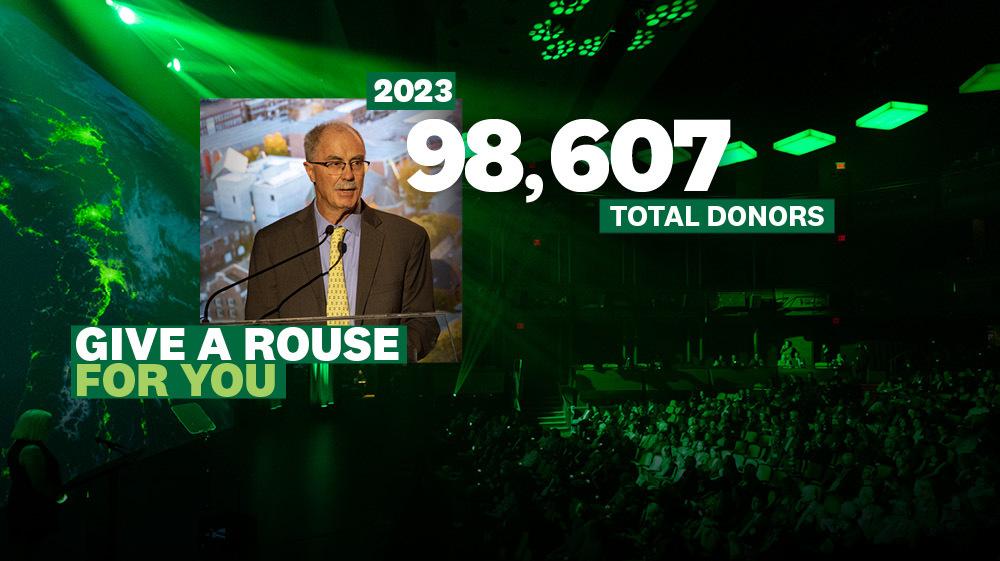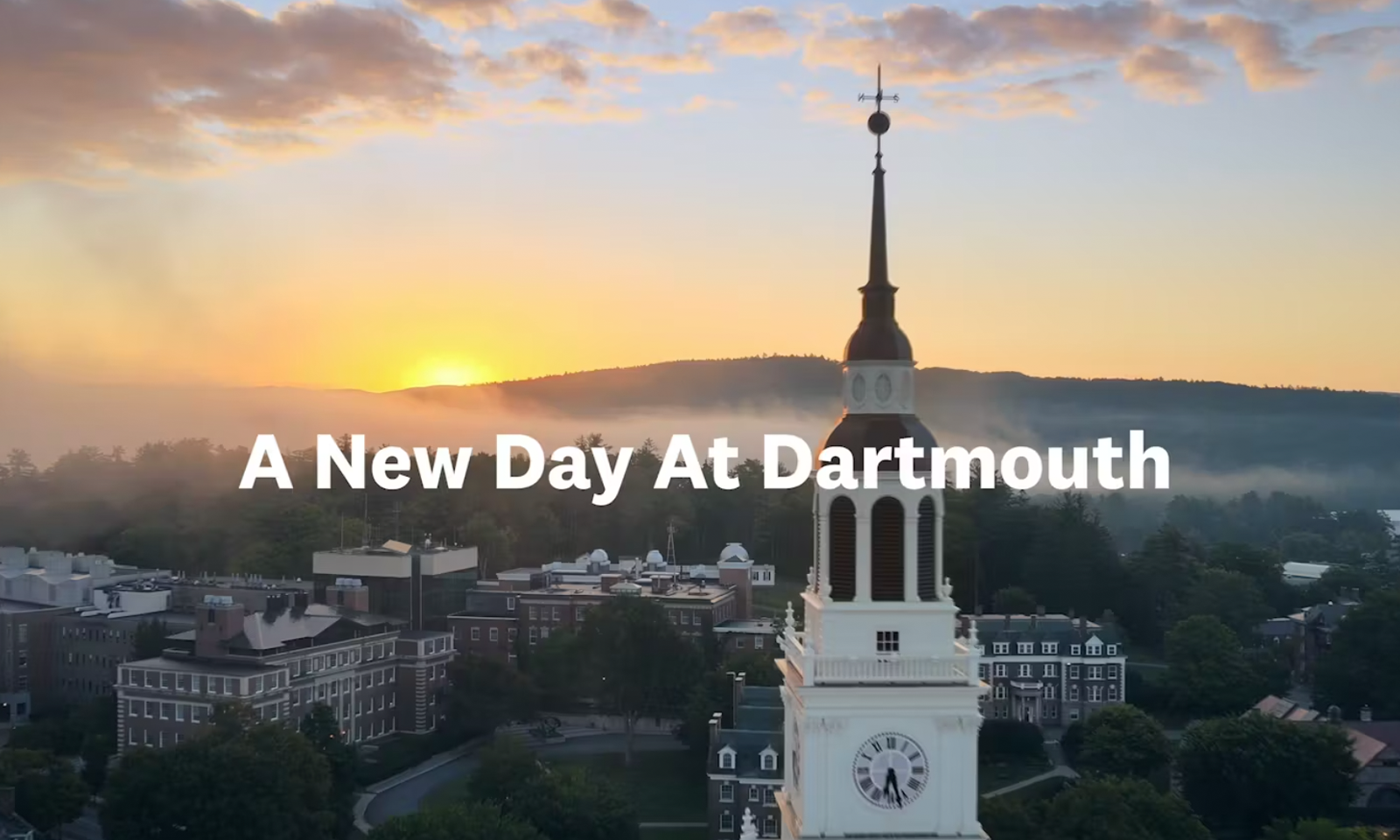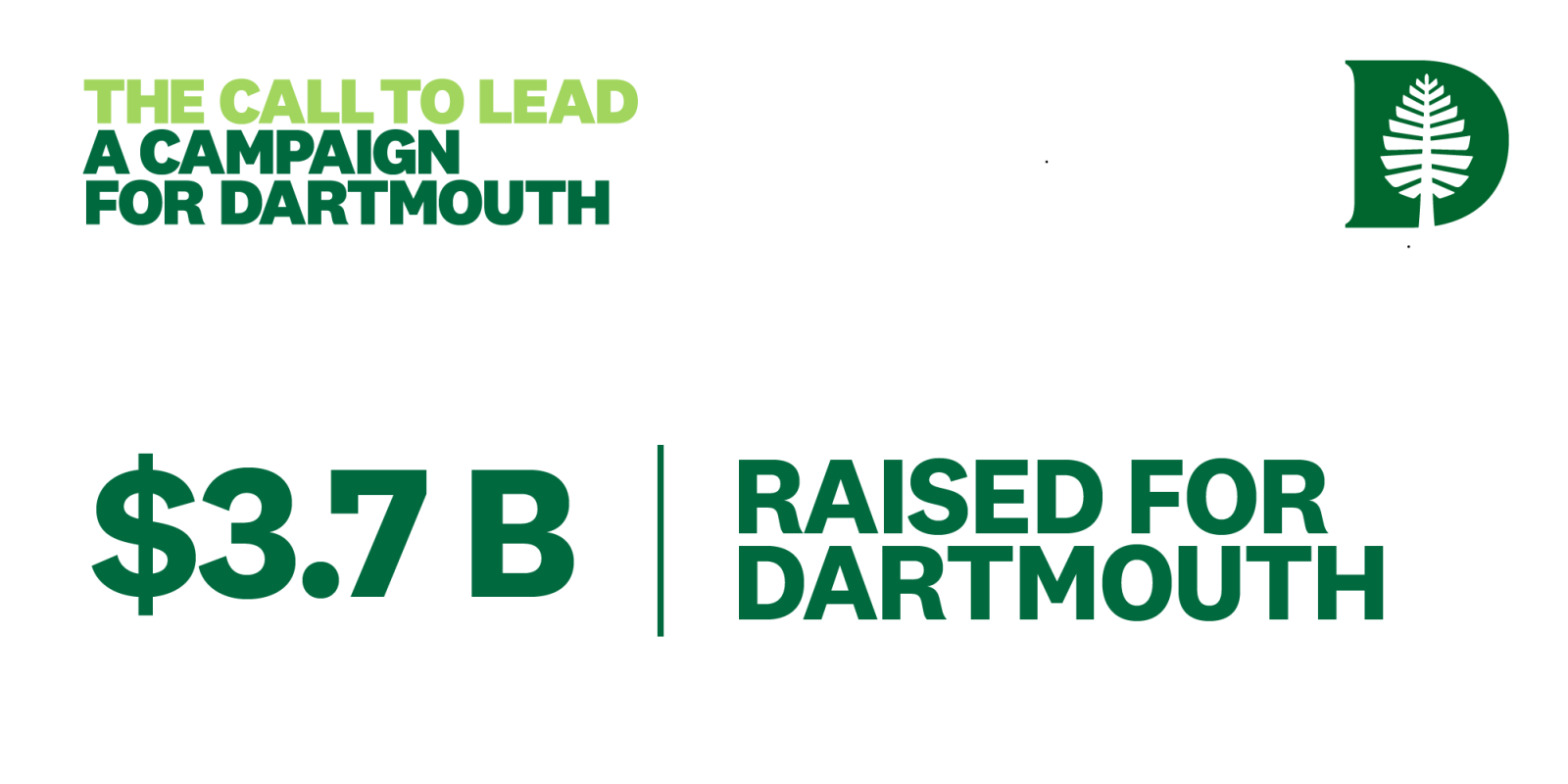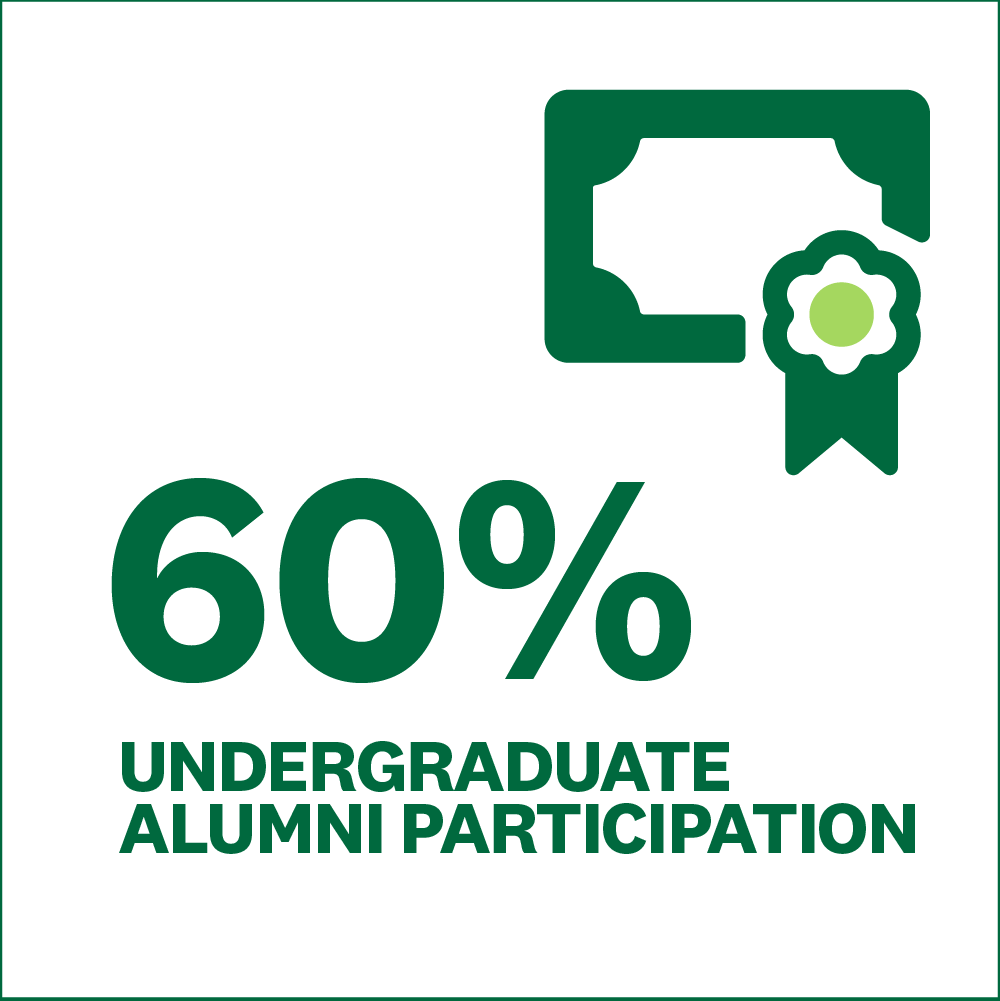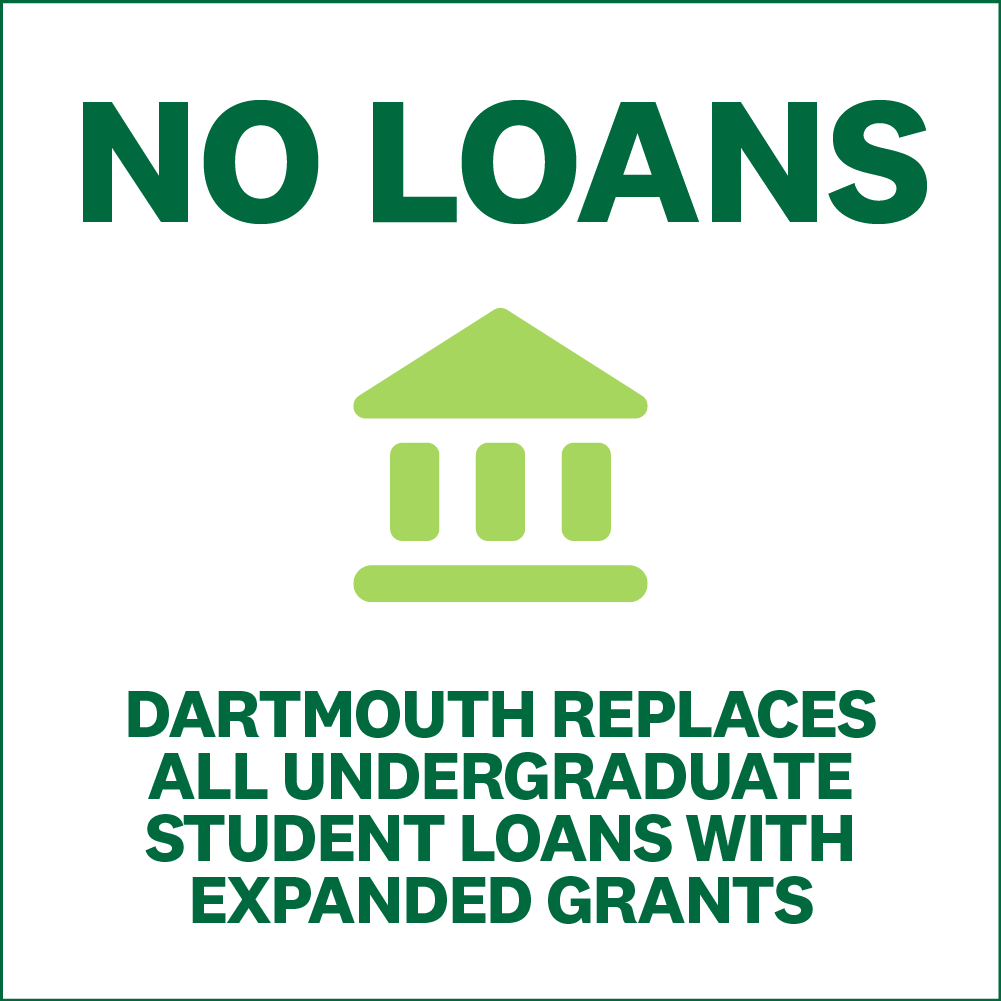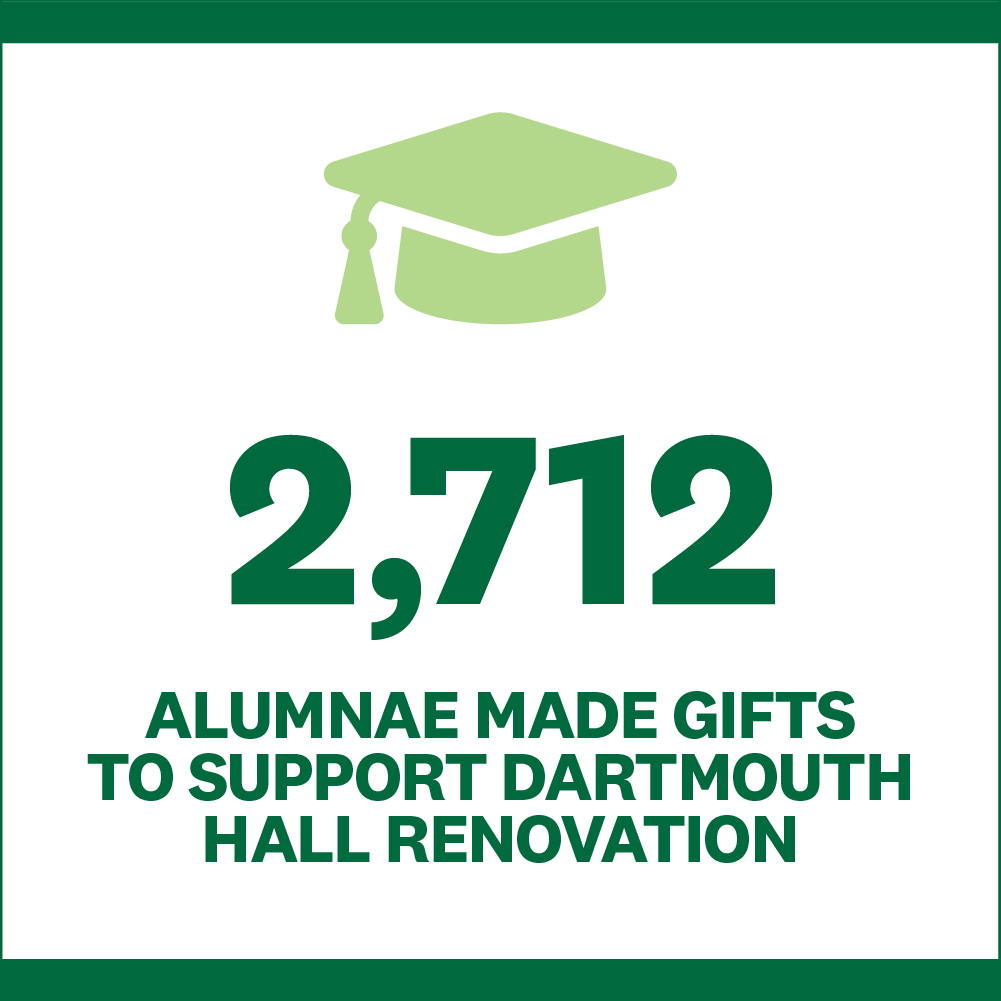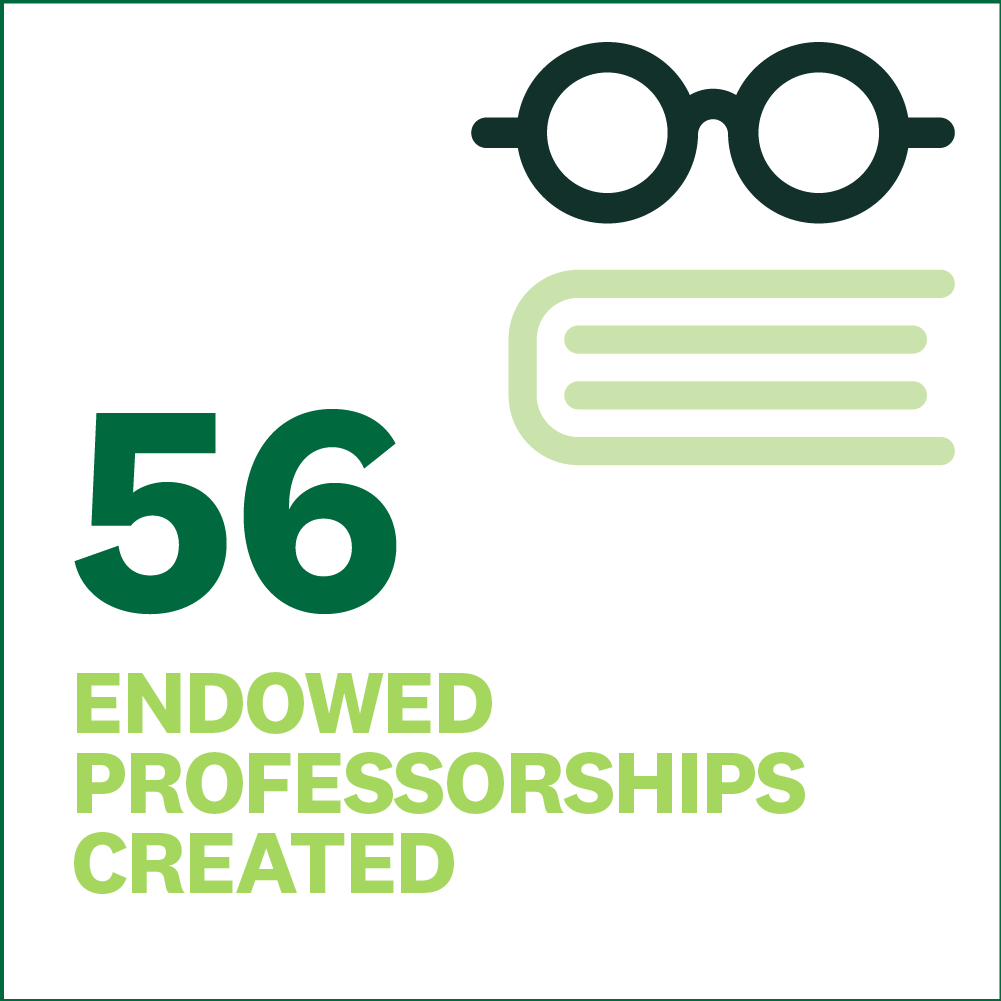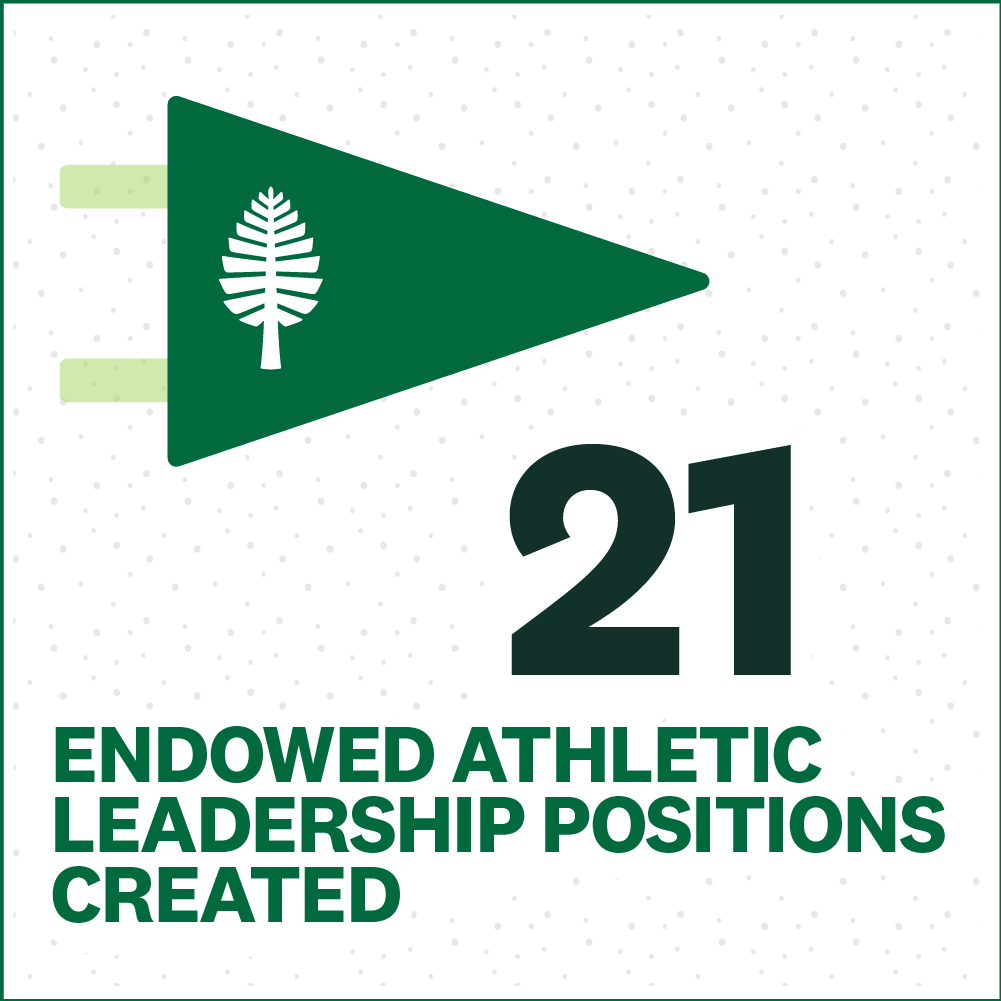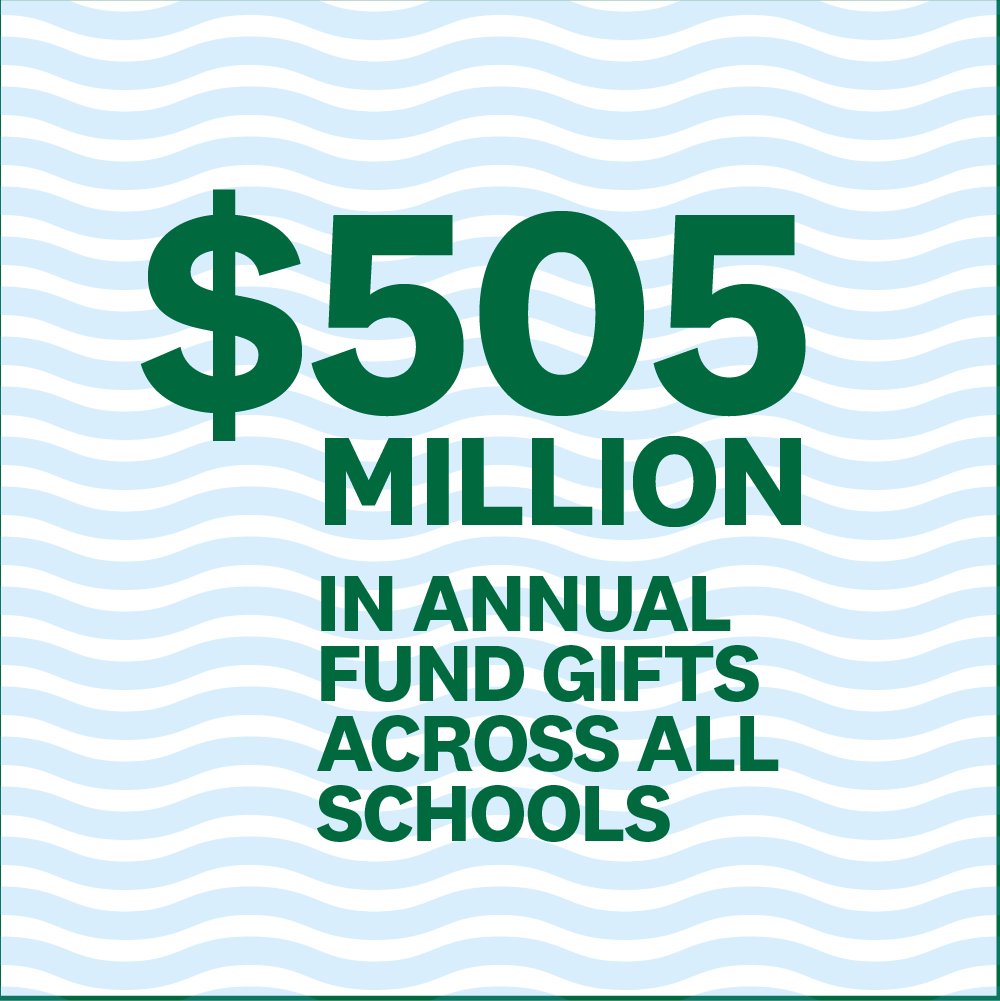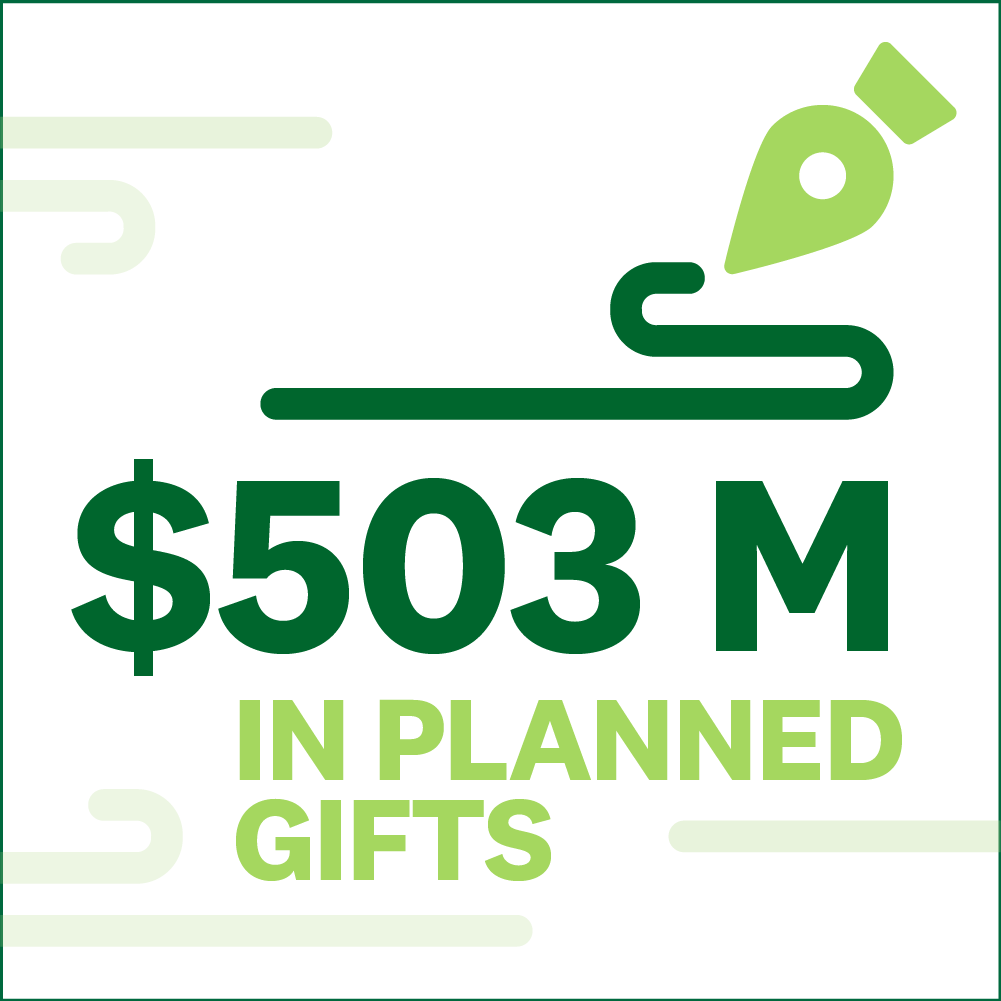History-Making Campaign Expands Dartmouth's Global Impact
With record 60% of alumni participating, The Call to Lead surpasses $3.7 billion

President Philip J. Hanlon ’77 today announced that The Call to Lead campaign, which will conclude on June 30, is the first higher education campaign worldwide with more than $3.7 billion in gifts and 60 percent undergraduate alumni participation.
“Our community’s historic accomplishment—a campaign with $3.7 billion in commitments to date and 60 percent alumni participation—is a resounding affirmation of the core values that define Dartmouth and our aspirations for the future,” says President Hanlon. “Ultimately, our success is measured not by funds raised but by lives changed and the impact we are having on the world.”
Take a look back at all the ground we've covered, and the revolutionary changes made, in the past 8 years.
Want to share on your social media?
Just copy the link below and paste in any post!
The Call to Lead has reaffirmed Dartmouth’s distinctive foundational strengths, particularly its commitment to the life-changing power of a liberal arts education, the breadth and capacity of the institution’s research enterprise, and its dedication to offering an academic experience that enables undergraduates to engage with faculty who are both leaders in their field and devoted teachers and mentors. The campaign has amplified Dartmouth’s distinct model in U.S. higher education as a fusion of a renowned liberal arts college and a robust research university.
The campaign’s theme of leadership inspired critical investments in both Dartmouth’s institutional capacity to find solutions to complex global issues and its time-proven ability to prepare young people for lives of leadership and impact.
At the same time, The Call to Lead has recast the institution in significant ways. The reimagining of two campus districts is fostering interdisciplinary collaboration and sparking creativity and discovery. The West End, dedicated to innovation, technology, and entrepreneurship, is driving hands-on collaboration across disciplines to meet some of the world’s greatest challenges. The Arts District is providing students with myriad opportunities to explore the arts as a component of their complete liberal arts experience. “Engagement with the arts has been shown to elevate resilience in the face of change, empathy and understanding of others, a capacity to solve problems,” President Hanlon told graduates at the 2019 Commencement.
More than $500 million in gifts for endowed scholarships has enabled a radical transformation of Dartmouth’s undergraduate financial aid offerings, deepening Dartmouth’s commitment to make a college education accessible and affordable for the most promising and talented students from around the world and from all economic backgrounds. Milestones include the elimination of required loans from all financial aid packages and ensuring that Dartmouth will meet all undergraduates’ demonstrated need. New scholarships for foreign study will enable all undergraduates who demonstrate need to experience learning outside the U.S. With this historic investment in endowed financial aid, Dartmouth today is one of only seven U.S. institutions to offer need-blind admissions to all undergraduates while meeting 100 percent of demonstrated need regardless of citizenship—and every student can now prepare for lives of impact with fewer constraints.
All five of Dartmouth’s schools participated in the campaign, including the Tuck School of Business, which notched an 81 percent alumni participation rate; Thayer School of Engineering; and Geisel School of Medicine. A new school, the Guarini School of Graduate and Advanced Studies, was established with campaign funding in 2016 and named for the Honorable Frank J. Guarini ’46.
Board of Trustees Chair Emerita Laurel J. Richie ’81, a campaign co-chair, has championed Dartmouth’s “Big Green, Big Tent” approach to making the campaign as inclusive as possible.
“This campaign has brought out the best in us: it has tapped into our noblest aspirations, it has inspired our abilities as leaders, and it has revealed our power when we act in community.”
The breadth of the campaign inspired unprecedented giving by alumni of color and international donors. Women’s leadership in The Call to Lead is also unprecedented, both as volunteers and as donors, with 115 women giving $1 million or more during the campaign, 318 making financial aid gifts of $100,000 or more, and 2,712 giving to the renovation of Dartmouth Hall.
“We’ve been witness to 90,000 acts of generosity,” says Senior Vice President for Advancement Bob Lasher ’88, referencing the campaign’s broad base of support. “In each individual gift, there is an act of faith, a vote of confidence, and a conscious choice to invest in Dartmouth’s future. We can see that philanthropy powers positive change. I join with my campus colleagues and campaign volunteers in expressing our gratitude. It’s awe-inspiring.”
Hundreds of Dartmouth community members have shared their inspiration for giving to The Call to Lead. Read their stories!
Positive impact across the institution
Nearly every metric of institutional strength has been on an upward trend since The Call to Lead’s launch. Recognition of Dartmouth’s academic vigor has benefited from the campaign, and in 2017 the Carnegie Commission on Higher Education designated Dartmouth an R1 top-level research institution. Two years later, Dartmouth was invited to join the Association of American Universities, a consortium of 65 leading U.S. public and private research universities.
Metrics for selectivity and yield have dramatically increased. The undergraduate admissions yield rate—the percentage of prospective students who accept Dartmouth’s invitation to matriculate—has risen from 50 percent to 70 percent. The strength and distinction of Dartmouth’s financial aid program has helped to convince applicants and their families of the affordability of a Dartmouth education. The average first-year undergraduate financial aid award has grown from $47,000 to $67,000—and student loans are no longer required.
Dartmouth has added more than 500,000 square feet of academic, athletic, and student life space for learning and leadership development, including the Class of 1982 Engineering and Computer Science Center, which houses the Magnuson Center for Entrepreneurship, Anonymous Hall, and the Graham Indoor Practice Facility. The campaign has also funded major renovations of the Hood Museum of Art, the Dartmouth Outing Club House, the Hopkins Center for the Arts, and—led by women—Dartmouth Hall.
A New Day at Dartmouth is upon us. Follow three students on a tour through a campus transformed through the Call to Lead.
Big, strategic bets on discovery
The campaign has expanded Dartmouth’s capacity to turn ideas into research and then into action, with an emphasis on urgent challenges that demand innovative, interdisciplinary thinking. Examples include:
- More opportunities for cutting-edge learning and research through the establishment of interdisciplinary centers and institutes such as the Arthur L. Irving Institute, Byrne Family Institute for Cancer Research, Magnuson Center, and Wright Center for the Study of Computation and Just Communities
- New pilot projects, or gifts to expand existing institutes, have intensified research and experiential learning opportunities in fields as diverse as Arctic studies, U.S. foreign relations and national security, Black intellectual life, and tribal sovereignty
- Recruitment of 30 faculty through the Academic Clusters Initiative, which has established 10 cohorts of scholars focused on issues that cut across disciplines, departments, and schools.
Five schools, one shared teacher-scholar model
The Call to Lead has reaffirmed Dartmouth’s commitment to the teacher-scholar model of education and the power of being a fusion of the best liberal arts college and a world-class research university. Initiatives include:
- Investments in faculty at each stage of their career, including establishment of the Society of Fellows, a community of postdoctoral scholars who are gaining essential classroom experience, and programs to recruit, nurture, and retain early-career faculty
- Greater opportunities for inter-departmental and inter-school student-faculty interaction through investments in the tech-forward West End District and the Arts District
- More than 300 endowed scholarships, 56 professorships, and expanded participation in five new interdisciplinary centers to enhance classroom learning and research experiences for students in the professional and graduate schools
Expanding access and preparing students for lives of leadership and impact
For more than 250 years, Dartmouth has provided students with the critical thinking skills necessary to lead effectively. Multiple initiatives funded through the campaign have built on this heritage and amplified Dartmouth’s greatest strengths:
- A record investment in athletics that provided more than 20 new endowed coaching positions, endowed Dartmouth Peak Performance program for all varsity athletes, and introduced several major new training facilities
- Expansion of the First-Year Summer Enrichment Program to a four-year program, which empowers first-generation and students from low-income backgrounds to thrive at Dartmouth
- A major initiative to address the diversity gap in the U.S. STEM workforce by increasing access and mentoring for historically underrepresented groups in science, technology, engineering, and mathematics
- Construction and renovation of facilities used by the Dartmouth Outing Club
- A significant expansion of internship opportunities
Alumni in record numbers engaged with Dartmouth
The breadth of the campaign’s goals has also strengthened bonds within the alumni community, as unprecedented giving by more than 98,000 donors rocketed The Call to Lead past its original goal of $3 billion.
The breadth of giving underscores broad support for The Call to Lead’s goals across the entirety of the Dartmouth community: total commitments nearly three times greater than Dartmouth’s previous campaign; 28,000 first-time donors; an 825 percent increase in international giving from donors in 105 countries; $503 million in bequest expectancies. And every gift to the campaign has been important to its success, with nearly 30 percent of all gifts less than $250, representing the broad expanse of the Dartmouth community.
The campaign’s eight co-chairs are Richie, Richard Kimball ’78, Elizabeth Mahoney Loughlin ’89, Philip Loughlin IV ’89, Gregory Maffei ’82, Sharon Maffei, Peggy Epstein Tanner ’79, and David Tanner. Each received a Presidential Commendation for Distinguished Service from President Hanlon in May in recognition for their exceptional service to Dartmouth.
President Hanlon will complete his 10-year tenure after this weekend’s Commencement. He will be succeeded by Sian Leah Beilock, currently president of Barnard College.
“The Call to Lead empowers the next generation at Dartmouth,” says President-elect Beilock. “It is a remarkable accomplishment to inherit as I start as president and will be the foundation on which we take the institution forward with influence and impact.”
THE FINAL THREE WEEKS
The Call to Lead will formally conclude on June 30, and Dartmouth invites all members of the community who haven’t yet made a campaign gift to join this historic endeavor. Giving priorities in the final weeks include the Dartmouth College Fund and the annual funds of the professional and graduate schools; expansion and renovation of the Hopkins Center; and support for the Class of 1982 Engineering and Computer Science Center.
